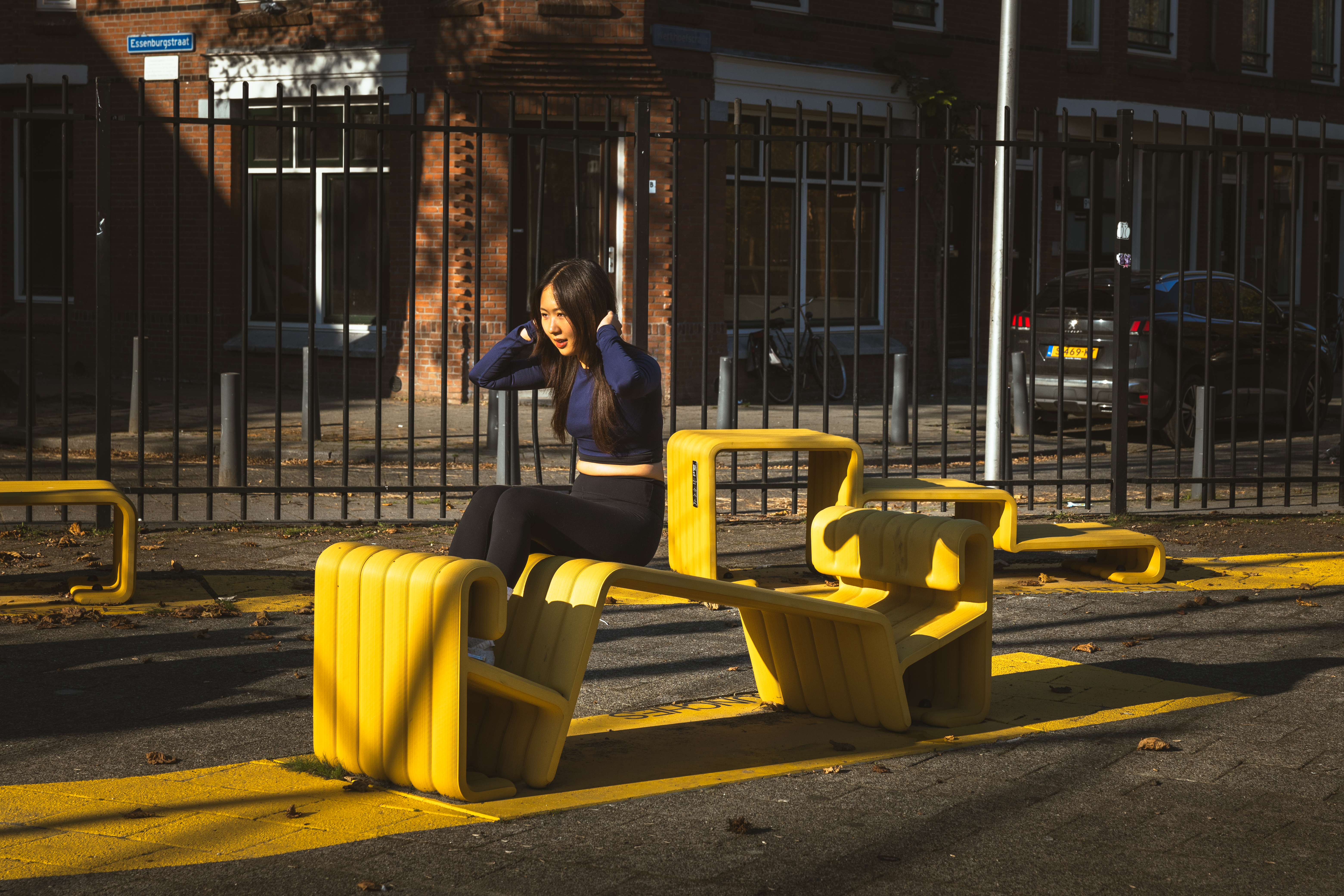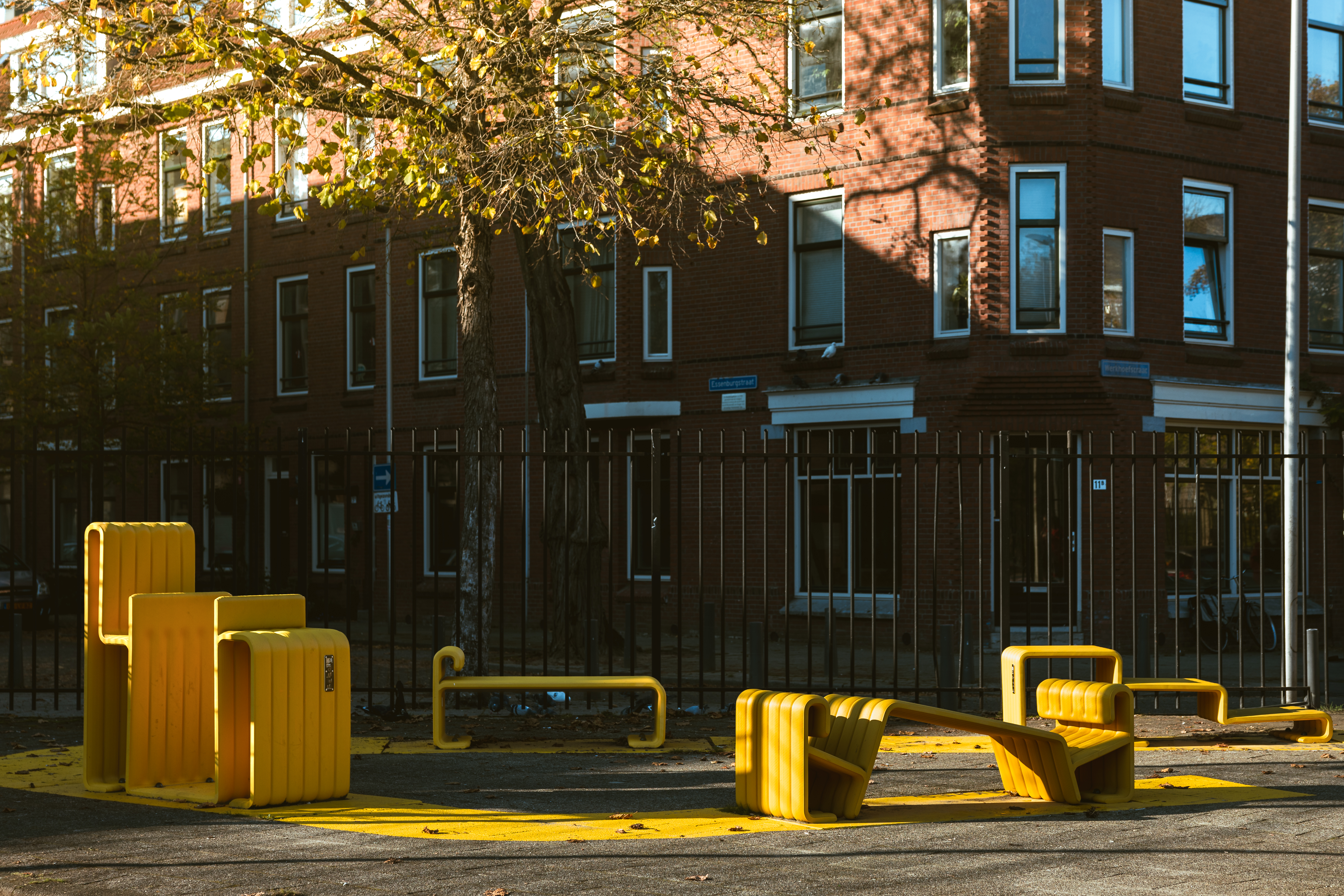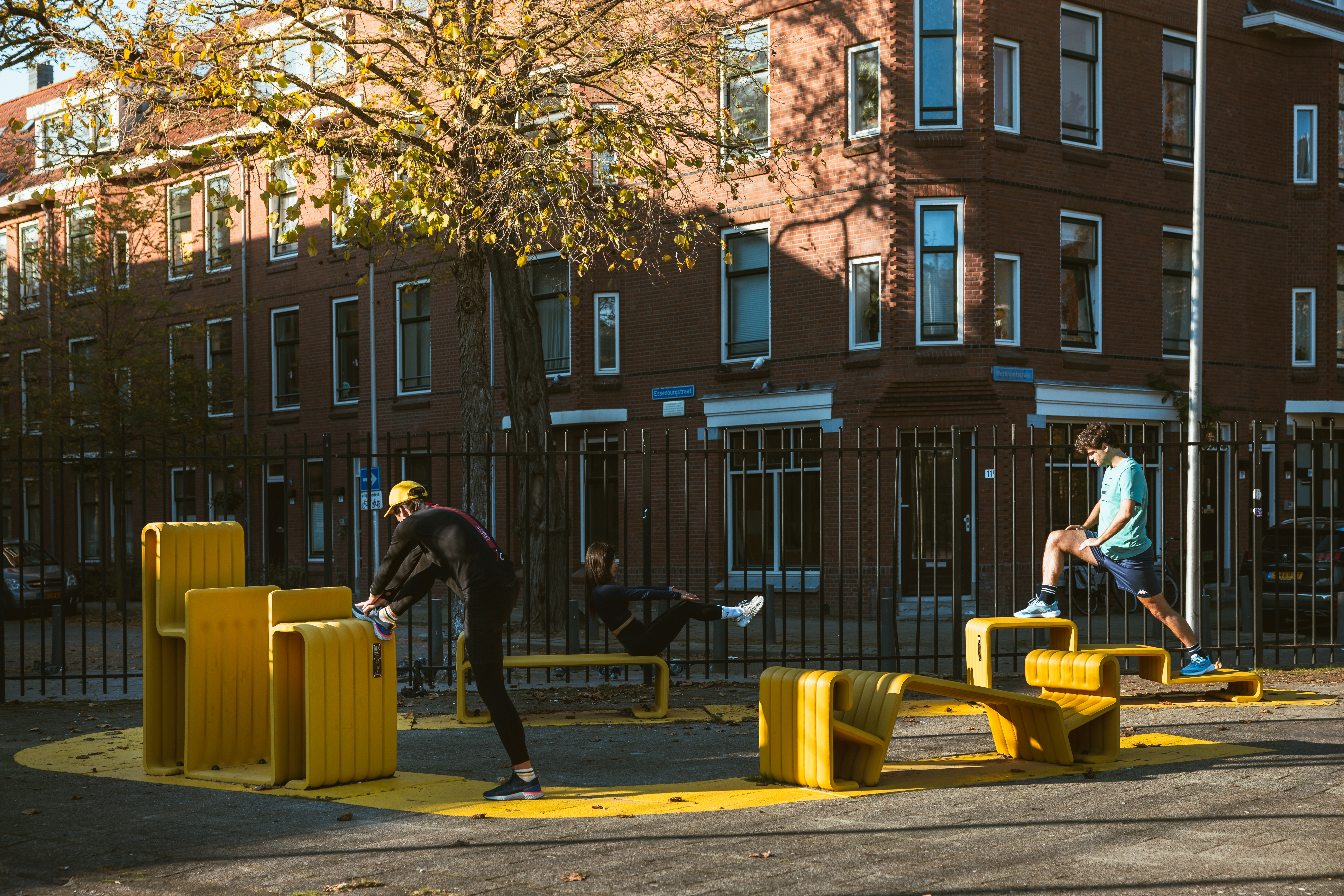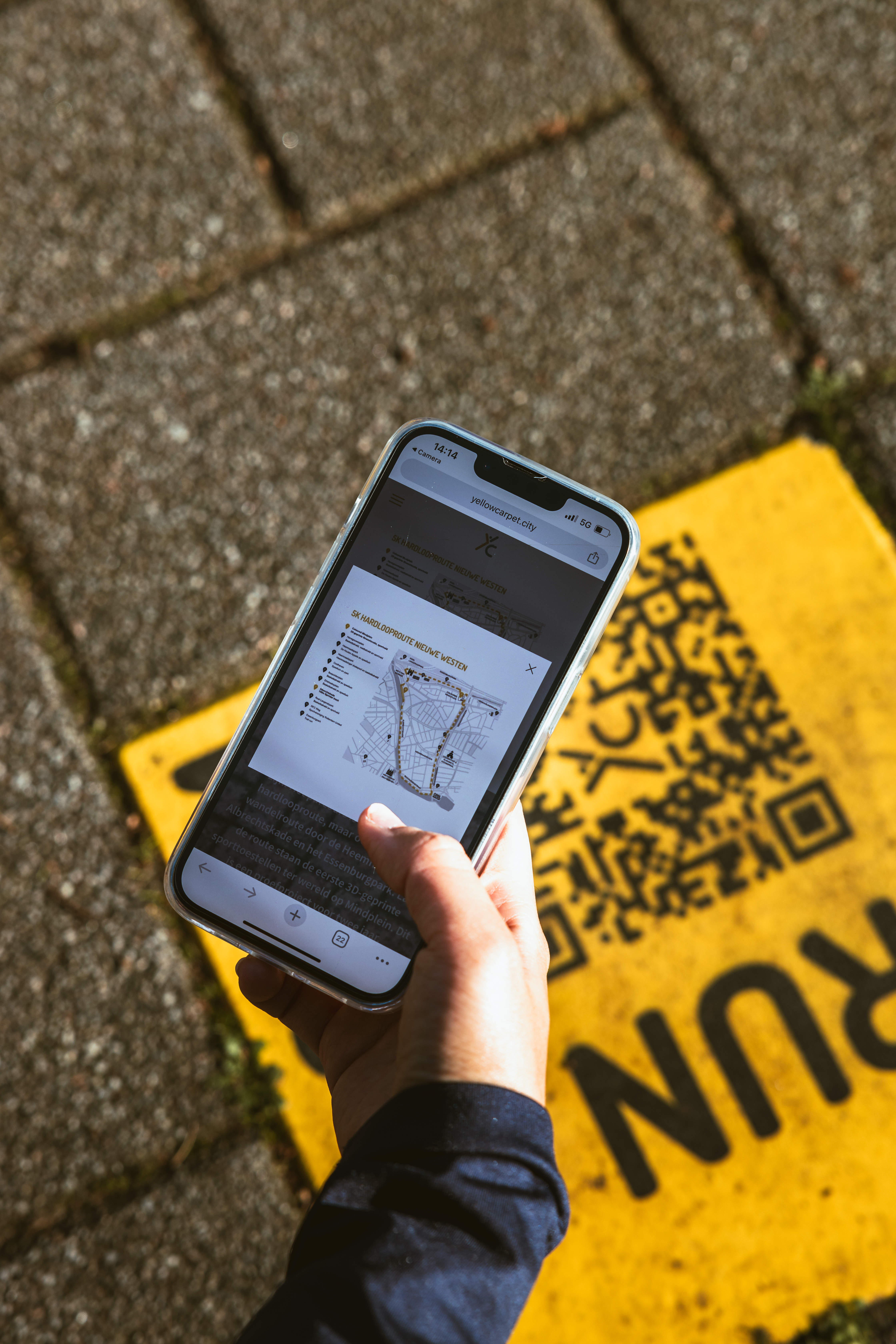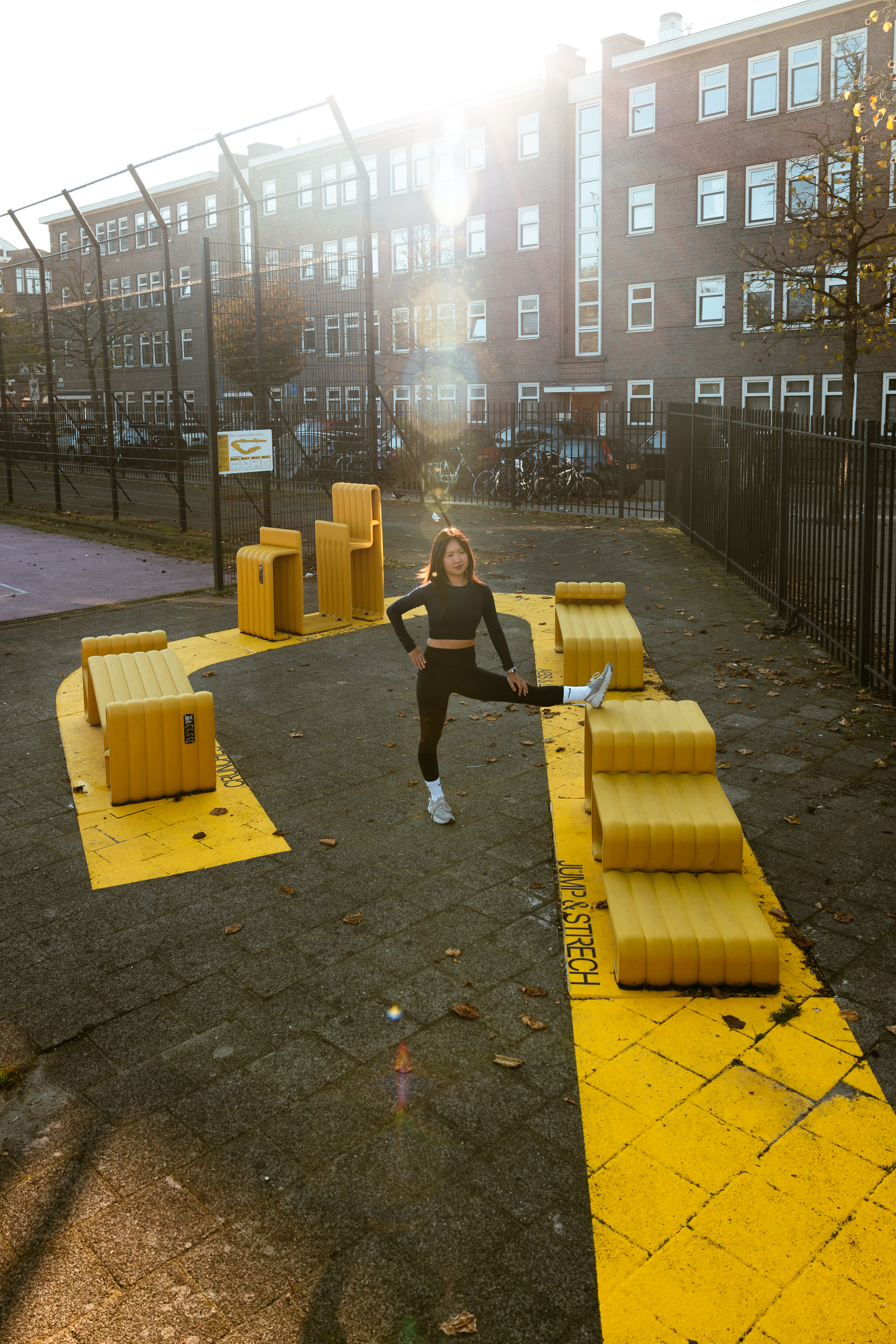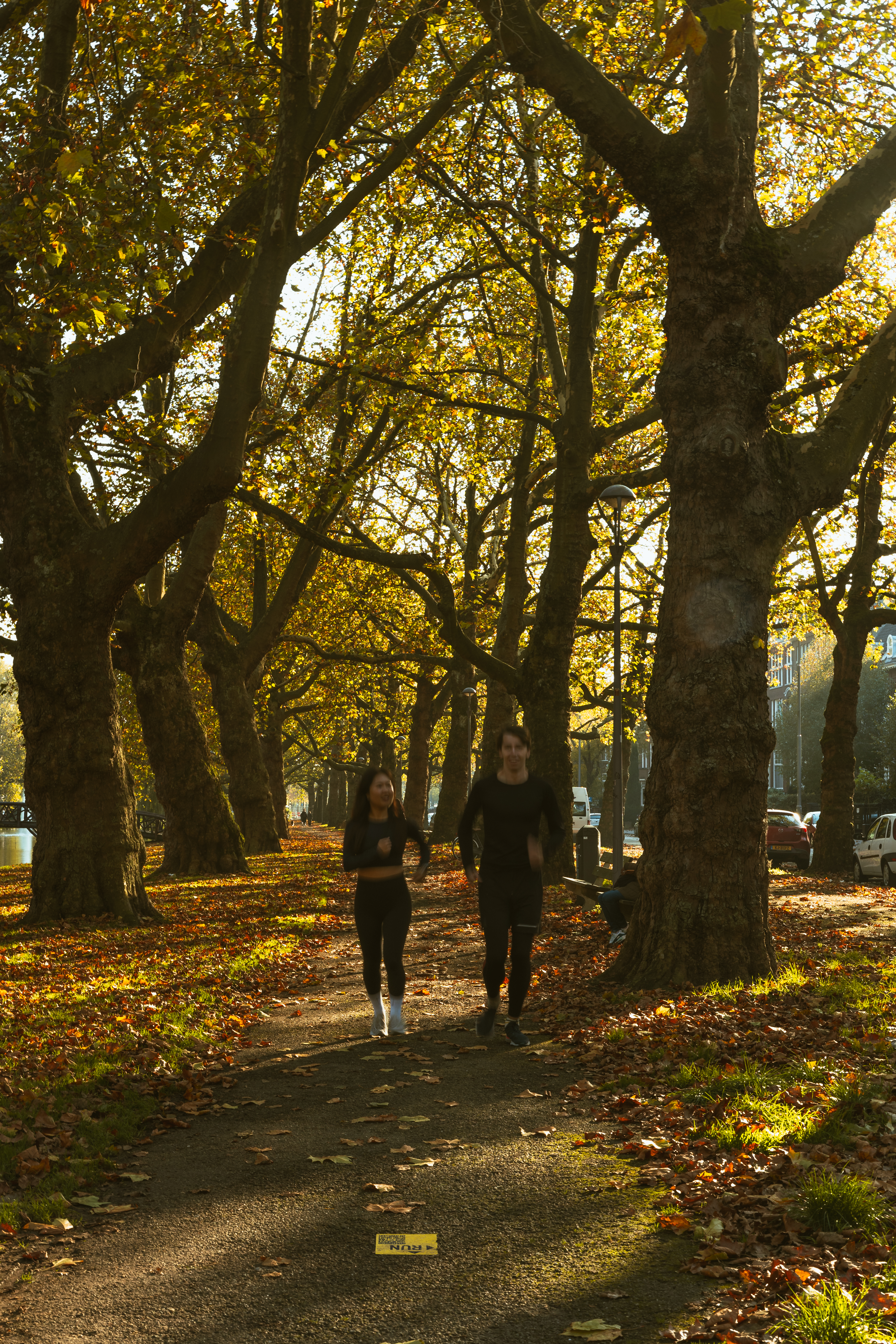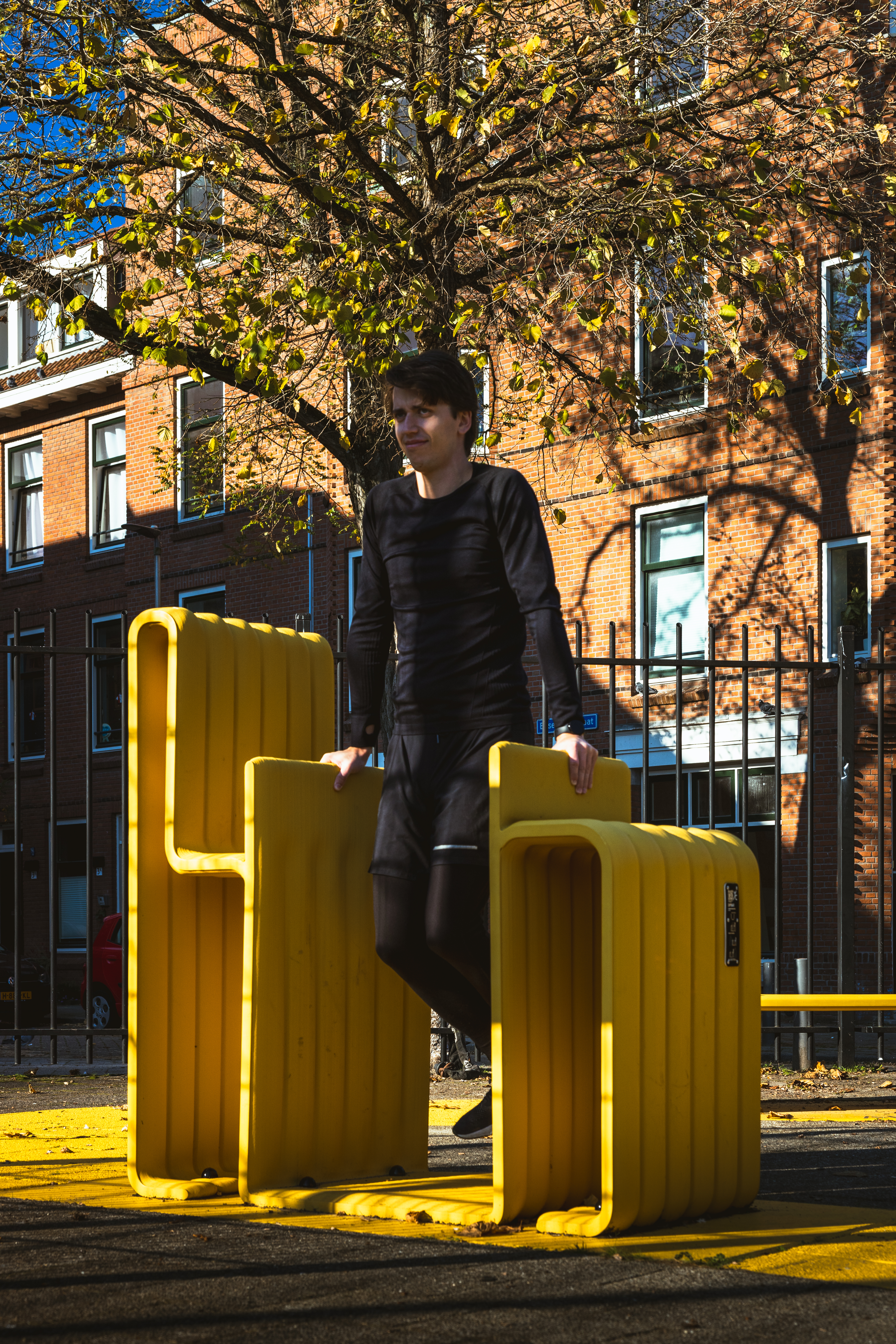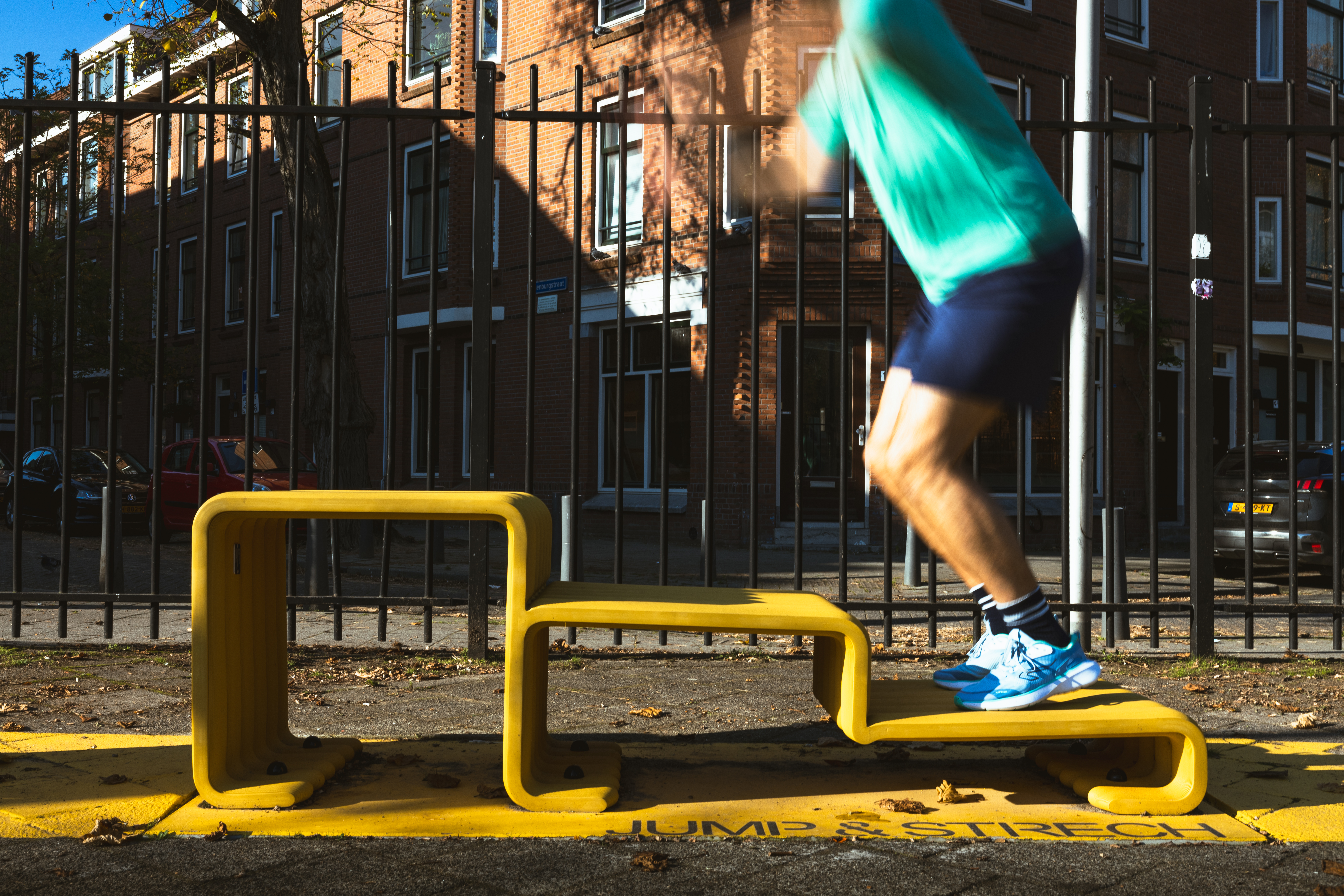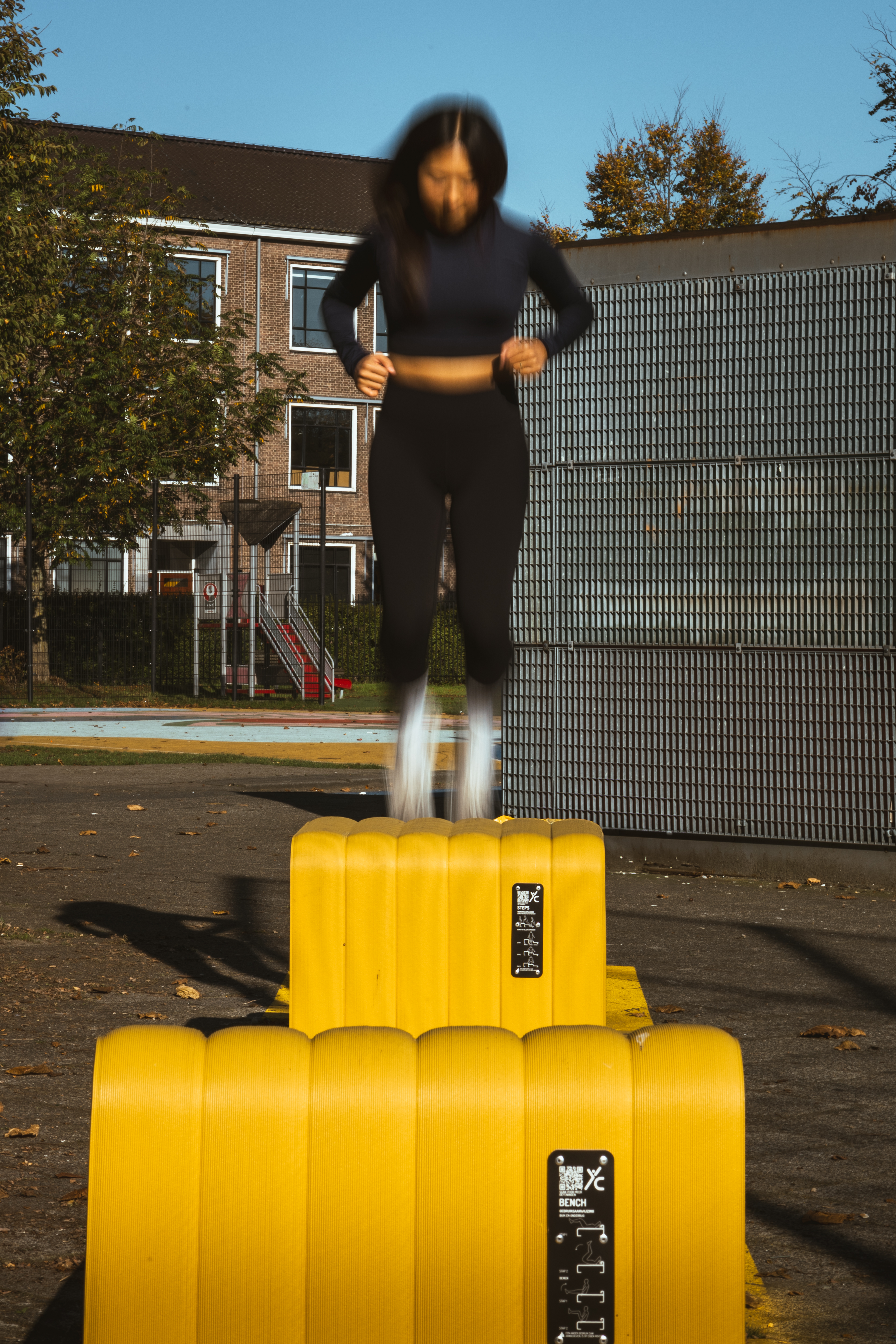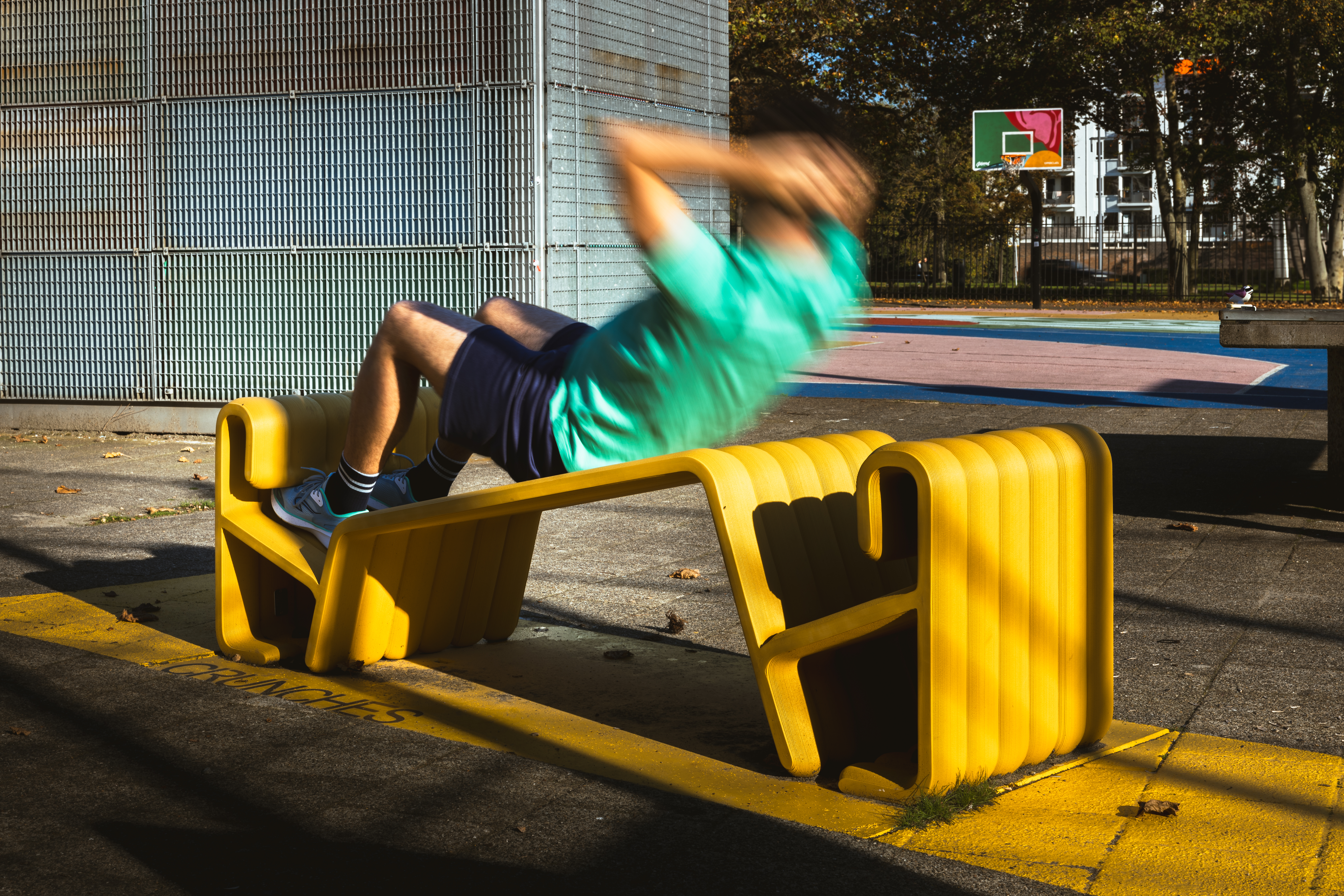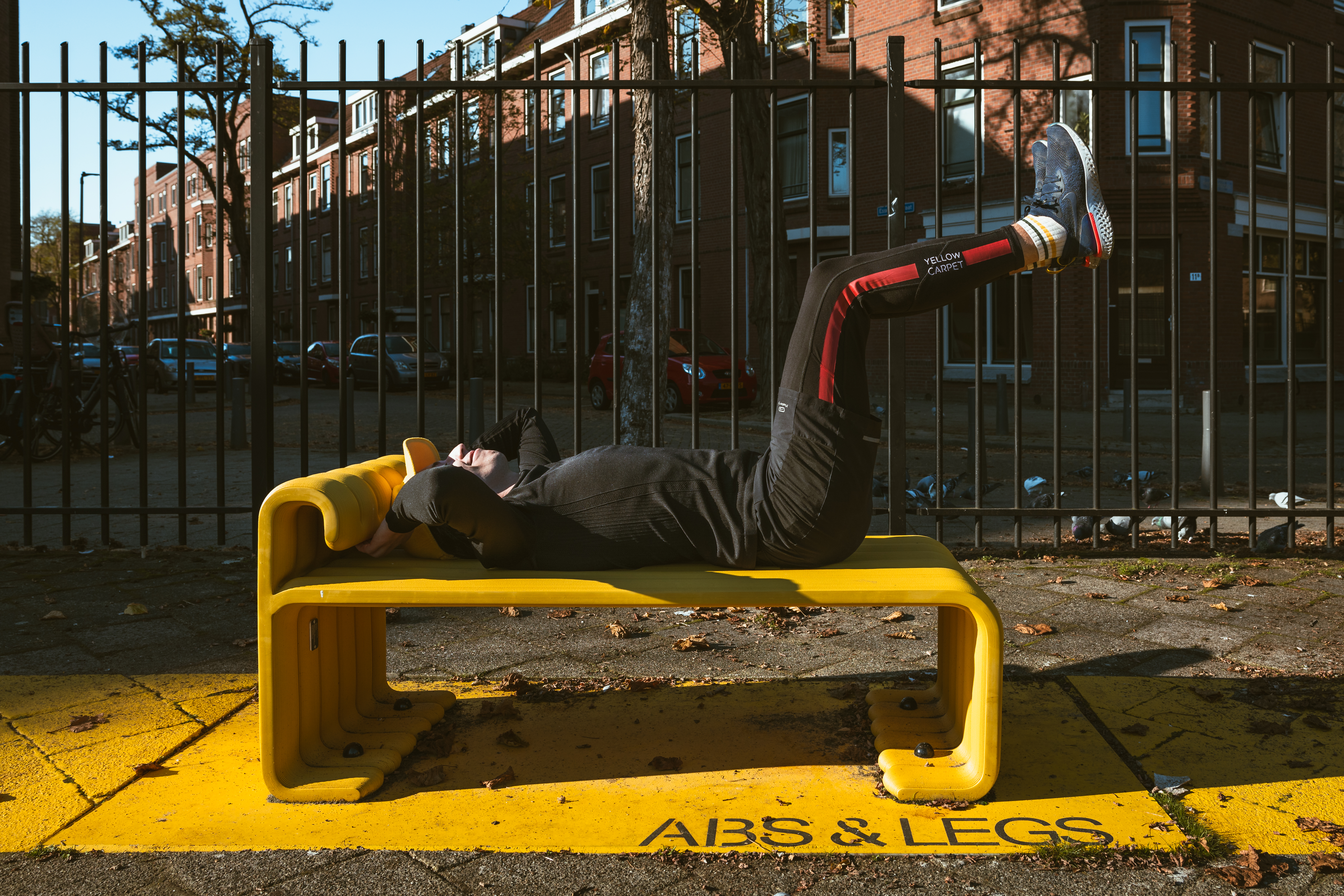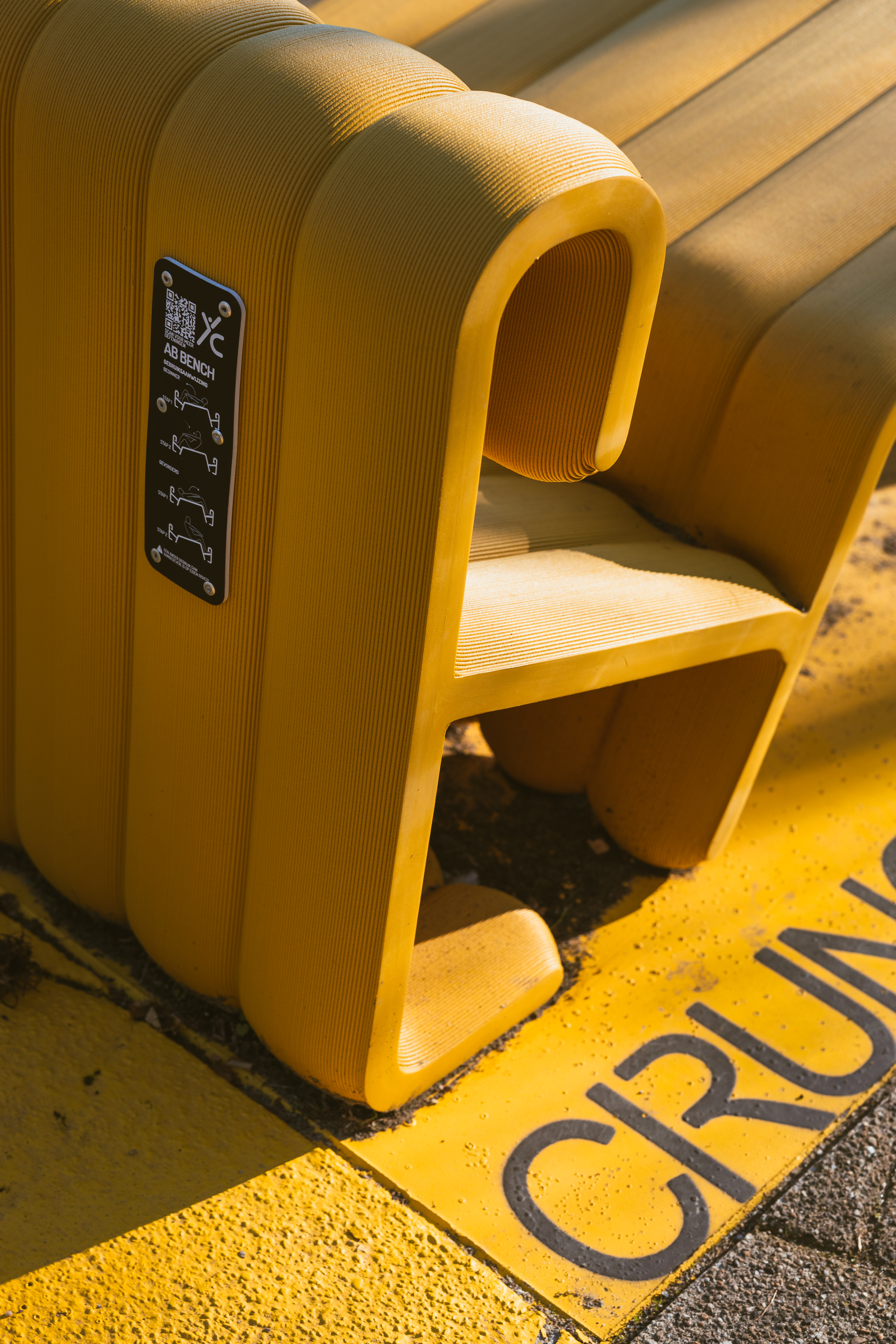Regaining a sense of belonging
Yellow Carpet
{Empty}
Yellow Carpet is a 5 km running ring and an innovative 3D-printed outdoor gym developed in a neighborhood in Rotterdam, The Netherlands. The project's objective is to create a network of exercise facilities accessible to everyone (in time, space and cost) to promote a healthy lifestyle, motivate inactive citizens to sport and stimulate the circular economy and new technology. Setting sport facilities in public spaces blends the boundaries between sports, play, culture and leisure time.
Netherlands
Local
Rotterdam
Mainly urban
It refers to a physical transformation of the built environment (hard investment)
Yes
2024-12-31
No
No
No
As a representative of an organisation, in partnership with other organisations
Due to urban densification, quality public space is becoming a luxury. With shrinking space for sports and outdoor activities, sports facilities are being pushed further outside the city, making them often exclusive and only accessible to a specific layer of society. Together with the sedentary lifestyle, this leads not only to social, physical, and mental health issues. Motivating people to be active and making sports visible in public is a critical mission many cities seek to achieve. Building resilience and developing a healthy urban environment is an urgent question that needs forward-thinking solutions.
Yellow Carpet tackles this by developing a 5 km running ring that connects existing outdoor sport facilities and adds a new 3D-printed outdoor gym location along the route. The objectives of the project are (1) to create a network of exercise facilities accessible to everyone (in time, space and cost), (2) to promote a healthy lifestyle and motivate inactive citizens to sport, (3) to activate and regenerate underused public space in the cities, (4) to stimulate the circular economy by using waste materials and (5) to explore the possibilities of innovative technology in the creation of an attractive product for outdoor fitness.
The project blends the boundaries between sports, play, street culture, leisure time and social interaction. By doing this, the project develops a culture of sport and increases the quality of life by making sport facilities accessible to all. Stimulating outdoor sports is an important aspect of urban culture that generates a long-term social impact. Designing and producing 3D-printed gym elements from local plastic waste boosts the circular economy and sets an example towards producing public amenities that are durable, recyclable, and attractive. As an outcome, the project builds on and stimulates the local culture of sport and contributes to the local innovation in craftsmanship and design.
Yellow Carpet tackles this by developing a 5 km running ring that connects existing outdoor sport facilities and adds a new 3D-printed outdoor gym location along the route. The objectives of the project are (1) to create a network of exercise facilities accessible to everyone (in time, space and cost), (2) to promote a healthy lifestyle and motivate inactive citizens to sport, (3) to activate and regenerate underused public space in the cities, (4) to stimulate the circular economy by using waste materials and (5) to explore the possibilities of innovative technology in the creation of an attractive product for outdoor fitness.
The project blends the boundaries between sports, play, street culture, leisure time and social interaction. By doing this, the project develops a culture of sport and increases the quality of life by making sport facilities accessible to all. Stimulating outdoor sports is an important aspect of urban culture that generates a long-term social impact. Designing and producing 3D-printed gym elements from local plastic waste boosts the circular economy and sets an example towards producing public amenities that are durable, recyclable, and attractive. As an outcome, the project builds on and stimulates the local culture of sport and contributes to the local innovation in craftsmanship and design.
repurposing of public spaces
sustainable and inclusive outdoor sports facilities
build a local culture of sport
innovative and attractive urban sports facilities
contribution to the contemporary healthy lifestyle
Yellow Carpet promotes the circular economy by using waste materials and exploring innovative technology to lower the environmental footprint while producing attractive outdoor fitness.
Dutch cities and urban regions are growing, resulting in a proportionate increase in plastic waste. However, only a small percentage of the material is recycled while the rest is incinerated, neglecting the full potential of this already existing resource.
Yellow Carpet addresses this issue by using local plastic waste to create a series of 3D-printed gym elements. By this, we ensure plastic waste materials are reused and handled locally, giving a renewed value to the material. The project aims to eliminate local plastic waste by creating a product that can be locally repurposed after its lifecycle, closing both the material and production loop.
The production method optimizes the plastics recycling process and enables urban dwellers to transform their plastic waste into valuable products through digital design and innovative fabrication technology. This zero-waste process empowered us to develop a circular and sustainable outdoor gym facility. Besides promoting better ways of using plastic waste, the project raises awareness of environmental issues related to waste management.
The objective of creating a circular and sustainable product has been achieved and greatly valued by all, especially by the trainers who were involved in the product’s design. By creating gym equipment from locally sourced plastic waste, the project demonstrates the potential of recycled materials in urban design, raising awareness about circular economy principles and potentially inspiring similar initiatives.
Yellow Carpet is a pioneering example of a 3D-printed outdoor gym facility implemented in a public space and, therefore, attractive and exemplary to future product and project developments.
Dutch cities and urban regions are growing, resulting in a proportionate increase in plastic waste. However, only a small percentage of the material is recycled while the rest is incinerated, neglecting the full potential of this already existing resource.
Yellow Carpet addresses this issue by using local plastic waste to create a series of 3D-printed gym elements. By this, we ensure plastic waste materials are reused and handled locally, giving a renewed value to the material. The project aims to eliminate local plastic waste by creating a product that can be locally repurposed after its lifecycle, closing both the material and production loop.
The production method optimizes the plastics recycling process and enables urban dwellers to transform their plastic waste into valuable products through digital design and innovative fabrication technology. This zero-waste process empowered us to develop a circular and sustainable outdoor gym facility. Besides promoting better ways of using plastic waste, the project raises awareness of environmental issues related to waste management.
The objective of creating a circular and sustainable product has been achieved and greatly valued by all, especially by the trainers who were involved in the product’s design. By creating gym equipment from locally sourced plastic waste, the project demonstrates the potential of recycled materials in urban design, raising awareness about circular economy principles and potentially inspiring similar initiatives.
Yellow Carpet is a pioneering example of a 3D-printed outdoor gym facility implemented in a public space and, therefore, attractive and exemplary to future product and project developments.
Yellow Carpet transforms and regenerates underused public spaces by developing new sport facilities and thus promotes the culture of sport and creates a unique and positive user experience. Activating underused public spaces is important in cities where spaces are scarce, and doing so in ways that promote well-being and a healthy lifestyle is essential for contemporary society. Creating a public place with amenities of unique character helps to activate and stimulate the culture of innovation, design and well-being. Yellow Carpet contributes to citizens' physical needs while embracing design innovation and introducing a new aesthetic in sport and recreation by treating the gym elements not simply like fitness equipment but rather like an art piece capable of elevating the aesthetic quality of the public space. This increases new opportunities for meaningful social interactions and collective experiences in the open public space.
Using 3D printing robotics gives a specific aesthetic that is often associated with modernity and innovation, making the sporting elements attractive to the youth as well as to many others. Furthermore, the outdoor gym location’s design reinterprets outdoor gym elements as sculptures in the open public space rather than an everyday facility, making it more inviting and aesthetically pleasing. The shapes and forms of the elements are designed for different users and various workouts. The outdoor gym, composed of four elements, was designed to offer full-body exercise (for beginners and more advanced users) and to integrate the community’s fitness needs.
The project's simple, minimalistic aesthetic, the elements' practical use, and the carefully re-designed urban space elevate the users' experience. In conclusion, Yellow Carpet activates underused public spaces to stimulate physical and mental well-being while promoting a culture of innovation and design and creating beautiful and inspiring places for the local community.
Using 3D printing robotics gives a specific aesthetic that is often associated with modernity and innovation, making the sporting elements attractive to the youth as well as to many others. Furthermore, the outdoor gym location’s design reinterprets outdoor gym elements as sculptures in the open public space rather than an everyday facility, making it more inviting and aesthetically pleasing. The shapes and forms of the elements are designed for different users and various workouts. The outdoor gym, composed of four elements, was designed to offer full-body exercise (for beginners and more advanced users) and to integrate the community’s fitness needs.
The project's simple, minimalistic aesthetic, the elements' practical use, and the carefully re-designed urban space elevate the users' experience. In conclusion, Yellow Carpet activates underused public spaces to stimulate physical and mental well-being while promoting a culture of innovation and design and creating beautiful and inspiring places for the local community.
Yellow Carpet is designed to connect different communities and enhance social inclusion and interaction. It creates a network of exercise facilities with a 5 km running ring that are inclusive by means of accessibility, affordability, and by connecting different communities. Since the project is implemented in an open public space, people can access it freely at any time. The project is accessible to everyone, including people with disabilities or physical limitations.
The 5 km running ring is envisioned as a walking and running route with markings on the sidewalk tiles, making it suitable for the elderly and others to walk part of the entire route. The path can be followed either by the signage on the sidewalk or by the freely accessible map on one’s telephone. As a result, the project reached its objective of being all-inclusive, accessible, and affordable. It is also exemplary because it is not only accessible to exclusive groups of users belonging to online running or walking route apps but also locally marked and to be followed without signing up for an application, making it local and inclusive to all residents.
Furthermore, the gym elements are designed for all levels of fitness, making it accessible to beginners and advanced users. Each element has been designed in a way that has different levels of difficulties, making it also usable to young and old. Users can access the user videos freely via their cell phones or follow the instructions on the information board at the location.
The 5 km running ring is envisioned as a walking and running route with markings on the sidewalk tiles, making it suitable for the elderly and others to walk part of the entire route. The path can be followed either by the signage on the sidewalk or by the freely accessible map on one’s telephone. As a result, the project reached its objective of being all-inclusive, accessible, and affordable. It is also exemplary because it is not only accessible to exclusive groups of users belonging to online running or walking route apps but also locally marked and to be followed without signing up for an application, making it local and inclusive to all residents.
Furthermore, the gym elements are designed for all levels of fitness, making it accessible to beginners and advanced users. Each element has been designed in a way that has different levels of difficulties, making it also usable to young and old. Users can access the user videos freely via their cell phones or follow the instructions on the information board at the location.
Yellow Carpet directly and indirectly benefits citizens by impacting their everyday lives, well-being, and urban environment. Firstly, it offers free, accessible fitness infrastructure for different age groups, making public spaces more inclusive and multifunctional. It encourages physical activity, thus contributing to the physical and mental well-being of citizens. Secondly, Yellow Carpet activates underused (and often neglected) urban spaces, making them more attractive and functional, increasing the safety of an open public space and promoting community interactions. Furthermore, the 5km route connects existing sports facilities, adding visibility to the existing sports infrastructure and raising citizens' awareness of the sports culture.
The citizens were indirectly involved through the active engagement of the local trainers, who acted as intermediaries representing community needs. Their participation as consultants and mediators was essential for the project in several ways. Their involvement in the equipment design and testing during the prototyping phase guaranteed the ergonomic quality of the gym equipment. Secondly, based on their daily interactions with residents, their insights ensured that the gym’s design meets the community’s fitness needs. Furthermore, the trainers involved in the project are from the local sports association, which works on programming sports activities within the local communities with special attention to the youth. This association supported the project with the users-guide video creation and uses the Yellow Carpet in their daily activities.
As the project began during the challenging times of COVID-19, which imposed significant limitations in organising workshops, citizens’ involvement was limited. Therefore, citizens were not directly engaged in the design process; however, their needs were represented by local trainers, who ensured a user-centred approach.
The citizens were indirectly involved through the active engagement of the local trainers, who acted as intermediaries representing community needs. Their participation as consultants and mediators was essential for the project in several ways. Their involvement in the equipment design and testing during the prototyping phase guaranteed the ergonomic quality of the gym equipment. Secondly, based on their daily interactions with residents, their insights ensured that the gym’s design meets the community’s fitness needs. Furthermore, the trainers involved in the project are from the local sports association, which works on programming sports activities within the local communities with special attention to the youth. This association supported the project with the users-guide video creation and uses the Yellow Carpet in their daily activities.
As the project began during the challenging times of COVID-19, which imposed significant limitations in organising workshops, citizens’ involvement was limited. Therefore, citizens were not directly engaged in the design process; however, their needs were represented by local trainers, who ensured a user-centred approach.
The main and long-term vision of Yellow Carpet is to create beautiful sporting places in dense urban environments by transforming local waste into a valuable product. To achieve this vision, diverse stakeholders were involved: (1) the municipality to ensure that the project aligned with local urban strategies, (2) different local and national experts for the ‘product’ design, and (3) local trainers who represented the local community and their needs. Each party was actively involved in the project at different stages and contributed to the final result, ensuring high-quality results.
The research and the design phase involved local architects, urban planners, and 3D designers/manufacturers. They represented the core transdisciplinary project team. At the local level, the involvement of a structural engineer and the local trainers as community representatives was essential. At the same time, engagement with the Kendoe-commission (a local district board of experts) and collaboration with the Rotterdam Municipality was crucial for the project's overall design and implementation within the city's urban context. At the national level, we engaged with Speelplan and TUV Nederland to ensure compliance with the national (and European) safety requirements and regulations. In the implementation phase, which entailed producing and installing the 5km running ring and 3D-printed outdoor gym, we worked closely with the Municipality’s public space management department (local level) and TUV Nederland (national level).
Considering the project's innovative nature, each party brought unique insight and expertise to the project and its objectives. The vital involvement of local designers and experts in the project enriches the local know-how for future pilot projects. The use of local plastic waste by the 3D printing manufacturers ensured the products’ circularity, creating the world's 1st locally 3D-printed outdoor gym.
The research and the design phase involved local architects, urban planners, and 3D designers/manufacturers. They represented the core transdisciplinary project team. At the local level, the involvement of a structural engineer and the local trainers as community representatives was essential. At the same time, engagement with the Kendoe-commission (a local district board of experts) and collaboration with the Rotterdam Municipality was crucial for the project's overall design and implementation within the city's urban context. At the national level, we engaged with Speelplan and TUV Nederland to ensure compliance with the national (and European) safety requirements and regulations. In the implementation phase, which entailed producing and installing the 5km running ring and 3D-printed outdoor gym, we worked closely with the Municipality’s public space management department (local level) and TUV Nederland (national level).
Considering the project's innovative nature, each party brought unique insight and expertise to the project and its objectives. The vital involvement of local designers and experts in the project enriches the local know-how for future pilot projects. The use of local plastic waste by the 3D printing manufacturers ensured the products’ circularity, creating the world's 1st locally 3D-printed outdoor gym.
The project integrated knowledge from diverse fields to achieve its objectives, engaging experts, regulatory bodies, and local community representatives. In particular, in the design and implementation phase of the project, participated the following disciplines: 3D printing experts for circular design and manufacturing, a certification company to ensure product safety, a structural engineer for stability and durability, local sports trainers for ergonomics consultation and exercise possibilities tailored to the community’s needs, urban designers and mobility experts for the integration of the running ring and gym location within the urban fabric, architects for the design of the gym location, university students for the support with the possible future digitalization of the running route, Rotterdam municipality and Kendoe-commission (a local district board of experts) to ensure the compliance with regulations.
The project initiators and architects guided the process, ensuring the participation and collaboration of the different experts based on the project's needs. Because of its innovative nature (e.g., using recycled plastic to develop a 3D-printed gym and creating a running ring that connects existing and new sport facilities, making it into a running parcours), the process was iterative, allowing space for creativity, exploration, and multidisciplinary co-creation.
Integrating the mentioned expertise was crucial for the project's success. The multidisciplinary collaboration ensured the project’s sustainability, inclusion, functionality, and beauty. It was particularly important the use of recycled plastic for the creation of safe, durable, and ergonomically designed 3D-printed outdoor gym equipment while providing technical innovation, regulatory compliance, and community relevance.
The project initiators and architects guided the process, ensuring the participation and collaboration of the different experts based on the project's needs. Because of its innovative nature (e.g., using recycled plastic to develop a 3D-printed gym and creating a running ring that connects existing and new sport facilities, making it into a running parcours), the process was iterative, allowing space for creativity, exploration, and multidisciplinary co-creation.
Integrating the mentioned expertise was crucial for the project's success. The multidisciplinary collaboration ensured the project’s sustainability, inclusion, functionality, and beauty. It was particularly important the use of recycled plastic for the creation of safe, durable, and ergonomically designed 3D-printed outdoor gym equipment while providing technical innovation, regulatory compliance, and community relevance.
The project aims to enrich the local context by adding sports facilities in dense urban environments and simultaneously address multiple urban challenges: plastic waste, public health, underused public space, and circular economy.
What differentiates Yellow Carpet from other city sports facilities is its approach to viewing the gym and running route as part of a broader urban infrastructure. It gives a sporting experience of a new ‘artistic’ spirit by treating the gym elements as sculptures in the urban environment. Yellow Carpet proposes and implements a running route in a densely populated neighbourhood close to the city centre, making it accessible to all and connecting the existing outdoor sports facilities.
At the same time, the project explores the idea of designing sports equipment in an innovative and groundbreaking way by using a large-scale robotic 3D printer and locally sourced recycled plastic for its production. Using large-scale robotic 3D printing and reusing local household plastic waste to design and produce these elements, we aimed to develop something exemplary of future possibilities for public amenities, especially in the field of sport and recreation. Mainstream outdoor fitness equipment is mainly not circular nor aesthetically appealing. To change this and to explore new means for public sports facilities, we created a new sustainable, inclusive and aesthetically pleasing product that had not yet been designed or produced and, therefore, it is innovative and a pilot.
Lastly, the project aims to create a functional and sculpture-like outdoor gym facility in the public space, evoking the idea of an art installation and adding a sense of pride and beauty to the urban environment to inspire and activate citizens.
What differentiates Yellow Carpet from other city sports facilities is its approach to viewing the gym and running route as part of a broader urban infrastructure. It gives a sporting experience of a new ‘artistic’ spirit by treating the gym elements as sculptures in the urban environment. Yellow Carpet proposes and implements a running route in a densely populated neighbourhood close to the city centre, making it accessible to all and connecting the existing outdoor sports facilities.
At the same time, the project explores the idea of designing sports equipment in an innovative and groundbreaking way by using a large-scale robotic 3D printer and locally sourced recycled plastic for its production. Using large-scale robotic 3D printing and reusing local household plastic waste to design and produce these elements, we aimed to develop something exemplary of future possibilities for public amenities, especially in the field of sport and recreation. Mainstream outdoor fitness equipment is mainly not circular nor aesthetically appealing. To change this and to explore new means for public sports facilities, we created a new sustainable, inclusive and aesthetically pleasing product that had not yet been designed or produced and, therefore, it is innovative and a pilot.
Lastly, the project aims to create a functional and sculpture-like outdoor gym facility in the public space, evoking the idea of an art installation and adding a sense of pride and beauty to the urban environment to inspire and activate citizens.
Yellow Carpet adopted a hybrid methodology merging systems thinking and design thinking to ensure a sustainable,user centered design with long-term community impact.
Applying systems thinking allowed addressing interconnected urban challenges such as resource use, health and well-being. The project ensures sustainability by viewing the gym and running route as part of the broader urban ecosystem and involving various stakeholders. Design thinking ensured the quality user experience and guaranteed that the final products met sustainability and community needs. Moreover, the project combines bottom-up and top-down approaches. Although local architects initiated the project, the idea and vision were based on their personal experience as citizens of the Rotterdam neighborhood where they lived. Following the initiation of the project, the Municipality was involved in the support with regulations and integration within urban fabrics.
The Yellow Carpet project was developed in four phases: Preparation & Research, Design, Certification, and Implementation. The Research phase created the foundation for the design phase in which, through an iterative process, we designed the gym elements and the 5km running ring in cooperation with various multi-level stakeholders. The initial activities included desk research on sports trends and best practices, urban surveys and mapping to determine optimal routes and locations for the gym and sprinter track installations. The iterative co-design phase entailed (1) transdisciplinary design sessions with experts and (2) co-creation with the Kendoe-commission (a local district board of experts) and Municipality. The permitting phase included preparing the documentation for the certification of gym elements and final approval after the installation. In the last phase, all components were produced (signage for a 5km running ring and sprinter track, four gym elements, information boards, and user videos) and installed in the neighborhood.
Applying systems thinking allowed addressing interconnected urban challenges such as resource use, health and well-being. The project ensures sustainability by viewing the gym and running route as part of the broader urban ecosystem and involving various stakeholders. Design thinking ensured the quality user experience and guaranteed that the final products met sustainability and community needs. Moreover, the project combines bottom-up and top-down approaches. Although local architects initiated the project, the idea and vision were based on their personal experience as citizens of the Rotterdam neighborhood where they lived. Following the initiation of the project, the Municipality was involved in the support with regulations and integration within urban fabrics.
The Yellow Carpet project was developed in four phases: Preparation & Research, Design, Certification, and Implementation. The Research phase created the foundation for the design phase in which, through an iterative process, we designed the gym elements and the 5km running ring in cooperation with various multi-level stakeholders. The initial activities included desk research on sports trends and best practices, urban surveys and mapping to determine optimal routes and locations for the gym and sprinter track installations. The iterative co-design phase entailed (1) transdisciplinary design sessions with experts and (2) co-creation with the Kendoe-commission (a local district board of experts) and Municipality. The permitting phase included preparing the documentation for the certification of gym elements and final approval after the installation. In the last phase, all components were produced (signage for a 5km running ring and sprinter track, four gym elements, information boards, and user videos) and installed in the neighborhood.
The Yellow Carpet project was developed as a pilot initiative designed to be replicated in other urban contexts. The project can be easily implemented in any location and be locally produced.
Although the project was developed at a local level, Yellow Carpet is a transferable and scalable solution for cities worldwide that addresses global challenges such as urban health, community well-being, local plastic waste management, and the adoption of circularity principles in terms of materials, products, and urban environments.
The running route can be mapped out and designed in different neighborhoods using the existing urban context and facilities to incorporate the local community’s fitness needs. Similarly, the 3D-printed gym equipment is designed to be modular and adaptable, with layouts that can be tailored to specific site conditions. The production process of the gym elements has been designed in a way that is meant to be produced locally in case of scale-up or transferring the idea to other cities nationally or internationally. The use of 3D printing technology not only supports material circularity by transforming local plastic waste into functional public infrastructure but also allows for design customization, enhancing the project’s flexibility and versatility.
Ultimately, Yellow Carpet is a replicable concept and model in its approach and methodology, in its technology and in its objectives. Adaptable to different urban environments and to the unique needs of local communities it provides a small, localized intervention that can drive meaningful changes to a varied range of people.
Although the project was developed at a local level, Yellow Carpet is a transferable and scalable solution for cities worldwide that addresses global challenges such as urban health, community well-being, local plastic waste management, and the adoption of circularity principles in terms of materials, products, and urban environments.
The running route can be mapped out and designed in different neighborhoods using the existing urban context and facilities to incorporate the local community’s fitness needs. Similarly, the 3D-printed gym equipment is designed to be modular and adaptable, with layouts that can be tailored to specific site conditions. The production process of the gym elements has been designed in a way that is meant to be produced locally in case of scale-up or transferring the idea to other cities nationally or internationally. The use of 3D printing technology not only supports material circularity by transforming local plastic waste into functional public infrastructure but also allows for design customization, enhancing the project’s flexibility and versatility.
Ultimately, Yellow Carpet is a replicable concept and model in its approach and methodology, in its technology and in its objectives. Adaptable to different urban environments and to the unique needs of local communities it provides a small, localized intervention that can drive meaningful changes to a varied range of people.
The project addresses the global challenge of (1) unhealthy urban lifestyles, (2) the inequality of accessible and affordable sports facilities, (3) local and global plastic waste management, (4) sustainable and circular urban development, and (5) the making public spaces resilient.
Many cities' visions are to stimulate citizens to have a healthier lifestyle. One way to achieve this is by providing sports facilities that are accessible to all and affordable to all layers of society.
Accessing sports facilities is often a challenge for people with low incomes. Therefore, implementing outdoor sports in low-income neighborhoods addresses a global issue on a local scale.
Transforming locally collected plastic waste into a new product eliminates the global challenge of plastic waste management and being incinerated or dumped into waterways. This promotes the reuse of waste and shows the potential of plastic as a valuable resource in the development of architecture and urban design.
Yellow Carpet addresses the global challenge of sustainable and circular design and urban development by reusing plastic waste and closes the loop by reusing materials and producing all elements locally. Local production eliminates the further need for logistics, lowering the carbon footprint in the implementation process. Engaging only local stakeholders and developers contributes on a larger scale to the circular economy and urban development. Moreover, repurposing and regenerating underused public spaces addresses the global challenge of urban resilience. Regeneration of public spaces to a diversity of use makes the public space and its community resilient; for example, in case of a pandemic with closed doors to indoor sports facilities. Therefore, the Yellow Carpet project not only promotes the development of resilience of public spaces but also the resilience of an urban community.
Many cities' visions are to stimulate citizens to have a healthier lifestyle. One way to achieve this is by providing sports facilities that are accessible to all and affordable to all layers of society.
Accessing sports facilities is often a challenge for people with low incomes. Therefore, implementing outdoor sports in low-income neighborhoods addresses a global issue on a local scale.
Transforming locally collected plastic waste into a new product eliminates the global challenge of plastic waste management and being incinerated or dumped into waterways. This promotes the reuse of waste and shows the potential of plastic as a valuable resource in the development of architecture and urban design.
Yellow Carpet addresses the global challenge of sustainable and circular design and urban development by reusing plastic waste and closes the loop by reusing materials and producing all elements locally. Local production eliminates the further need for logistics, lowering the carbon footprint in the implementation process. Engaging only local stakeholders and developers contributes on a larger scale to the circular economy and urban development. Moreover, repurposing and regenerating underused public spaces addresses the global challenge of urban resilience. Regeneration of public spaces to a diversity of use makes the public space and its community resilient; for example, in case of a pandemic with closed doors to indoor sports facilities. Therefore, the Yellow Carpet project not only promotes the development of resilience of public spaces but also the resilience of an urban community.
Urban densification reduces public spaces for sports and outdoor activities, making them increasingly exclusive and inaccessible, contributing to social, physical, and mental health issues. The Yellow Carpet project addresses this challenge by developing a 5 km running route that connects existing outdoor sports facilities and includes a new 3D-printed gym made from waste materials. Its objectives include making exercise facilities accessible to all, promoting a healthy and active lifestyle, revitalizing underused urban spaces, supporting the circular economy through waste repurposing, and utilizing innovative technology to create engaging outdoor fitness spaces. By blending sports, play, and street culture, Yellow Carpet fosters an inclusive sports culture, improves urban life quality, and encourages local innovation. With a strong focus on sustainability, inclusivity, and innovation, the project sets a new standard for modern urban sports and furniture development.
Yellow Carpet successfully demonstrates the potential of waste materials in urban design by creating a 3D-printed outdoor gym from locally sourced plastic waste. This innovative approach optimizes plastic recycling, reduces environmental impact, and promotes a circular economy. The project revitalizes underused public spaces by introducing innovative outdoor sports facilities that promote a culture of sport, well-being, and social interaction. By treating gym elements as sculptural pieces it enhances the aesthetic quality of public spaces, making them more inviting and engaging. This project not only meets physical and mental well-being needs but also fosters innovation, creativity, and community engagement, transforming urban spaces into inspiring and inclusive environments. By prioritizing affordability, accessibility, and inclusivity, YC successfully promotes health, well-being, and community engagement in public spaces.
Yellow Carpet successfully demonstrates the potential of waste materials in urban design by creating a 3D-printed outdoor gym from locally sourced plastic waste. This innovative approach optimizes plastic recycling, reduces environmental impact, and promotes a circular economy. The project revitalizes underused public spaces by introducing innovative outdoor sports facilities that promote a culture of sport, well-being, and social interaction. By treating gym elements as sculptural pieces it enhances the aesthetic quality of public spaces, making them more inviting and engaging. This project not only meets physical and mental well-being needs but also fosters innovation, creativity, and community engagement, transforming urban spaces into inspiring and inclusive environments. By prioritizing affordability, accessibility, and inclusivity, YC successfully promotes health, well-being, and community engagement in public spaces.

